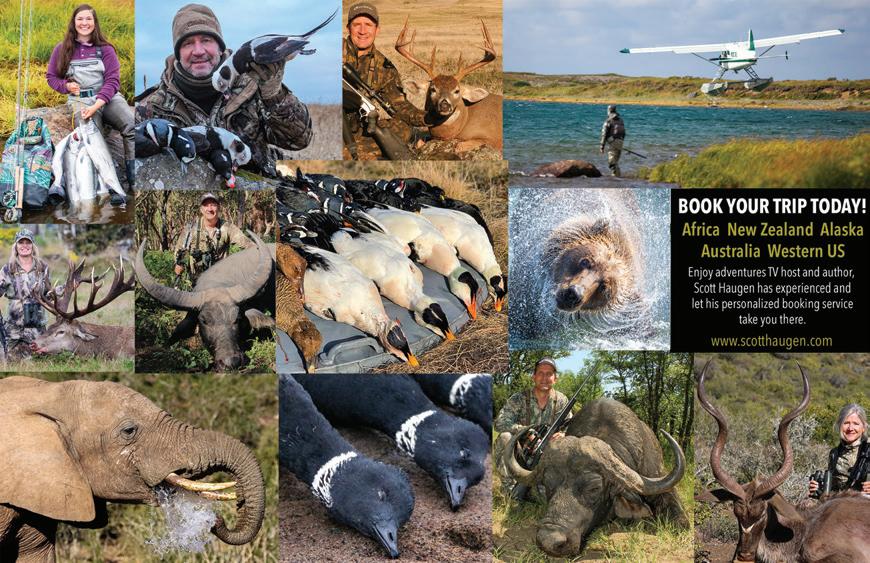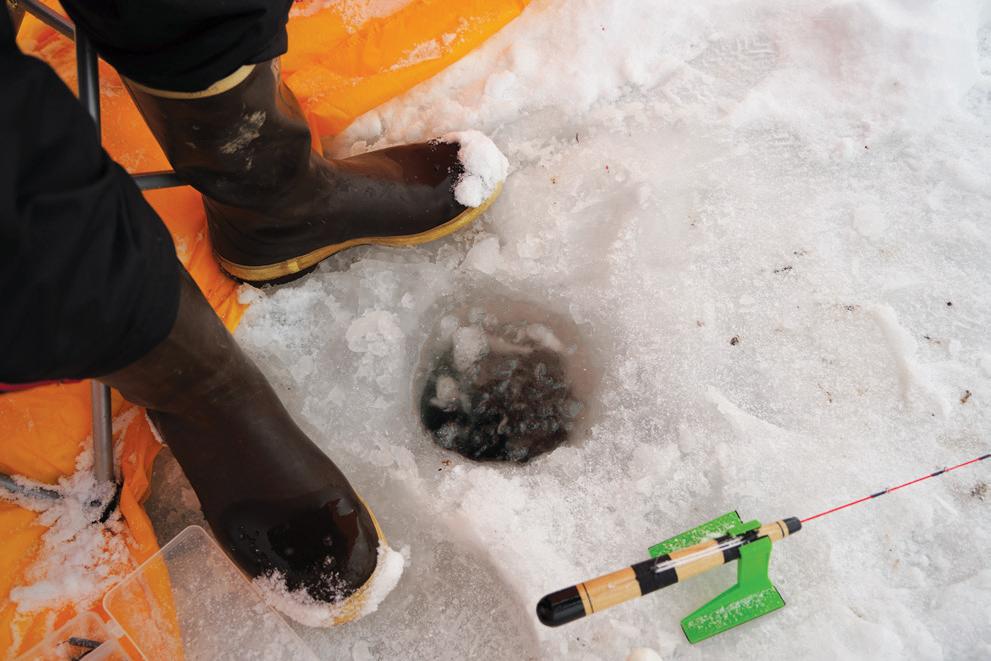
17 minute read
ICE FISHING AFAR
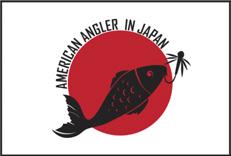
THE ICE BREAKER
A FORMER CALIFORNIAN GETS HIS FIRST FROZEN FISHING EXPOSURE IN JAPAN
By Lance Sawa
Ice fishing always fascinated me as a kid, even as I grew up in Southern California.
You sit around a hole in the ice – sometimes in a wood shanty to keep warm – hoping to catch something. The safety of the ice was the biggest reason I didn’t try it by myself. Another was that I didn’t know of anybody else who was interested in ice fishing. Going out onto a frozen lake alone and most likely not having

Japan’s Nagano Prefecture – site of the 1998 Winter Olympics – offers lots of ice fishing opportunities and it was here that author and Southern California expat Lance Sawa, who in his youth dreamed of trying his luck on a frozen lake, finally got his chance to fish through the hard water. (LANCE SAWA)

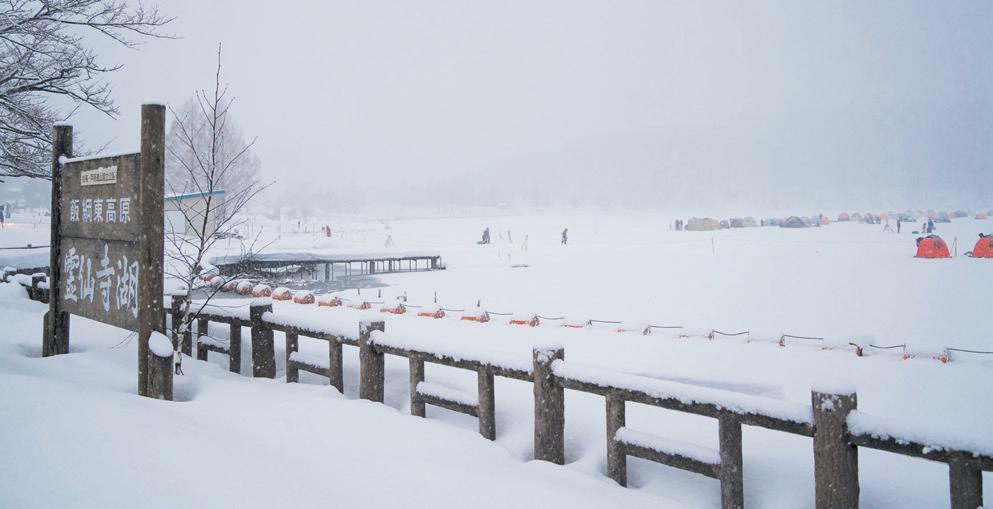
Reisenji Lake in the town of Iizuna is close to Sawa’s home, but he still faced a snowy drive and a line of fellow anglers hoping to get on the ice to try their
luck. (LANCE SAWA)
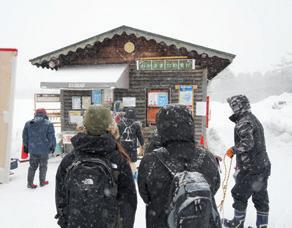
the correct equipment all made it a bit too daunting for young me.
Sometimes I would read articles about ice fishing and see all the types of fish that were brought up through that tiny hole. With their great taste, crappie and bluegill were the staple catch. Pike, walleye and trout were the large fish that barely fit through the hole and what prompted you to brag about to your fellow fishing buddies. I didn’t think my first ice fishing experience would be for finger-sized fish.
LAST YEAR I WENT fishing for Japanese wakasagi smelt, but it was in a heated enclosed boat – not ice fishing at all. I was so warm that I soon had to take off my jacket and sweater, as I was sweating. There were bathrooms on board and boiling water on hand at all times for your cup of noodles.
It was great fun and I promised myself to go back, but then COVID-19 happened. The thought of spending a full day in an enclosed boat with a bunch of strangers just didn’t sit well with me.
Reisenji Lake in Iizuna is not far from my house in Nagano Prefecture, northwest of Tokyo, and has ice fishing. When I went to look for fishing licenses for the year, I noticed that the lake’s ice fishing would start the next day, a Sunday.
I bought bait and picked up a fishing rig with tiny hooks. On Saturday night I went to sleep early and was up well before the sun rose to get to the lake at the opening time of 6 a.m.
Overnight the roads had frozen and snow had begun to fall, so the drive was slower than I planned. I arrived at the lake at 6:30, which was still before the sun came up, though the fishing area was already packed.
Most of the parking lots were full and some people were getting creative with where to park. Luckily, I found a spot at a nearby park. The walk was only about three minutes and I passed the local onsen, or hot springs, resort – their tengu (a mythical Japanese creature) statues were covered in snow.
All the little tents were set up on the ice and many had a light inside. After paying for my day pass to fish, I walked down the ramp onto a frozen lake for the first time.
A worker drilled a hole in the ice for me that I paid for. He directed me to a place he thought had fish. Even though it seemed many people were on the edges of the border, he placed me 20 feet away.
After thanking him I set up my pop-up summer tent with the hope it would keep the wind and snow at bay. It didn’t do a good job.
I set up the mini rod with the fishing rig I had bought earlier and put the cut bait on my hooks. It was time to fish under the ice for the first time. I was so excited that I forgot about the cold weather.
MY LINE WENT STRAIGHT down into the
cold, green and clean water. The strikes came fast and quick, but I couldn’t quite hook anything. Then the bite slowed, so I changed the bait because I remembered that these fish were greedy but picky eaters. Afterwards I got more bites, but again was unable

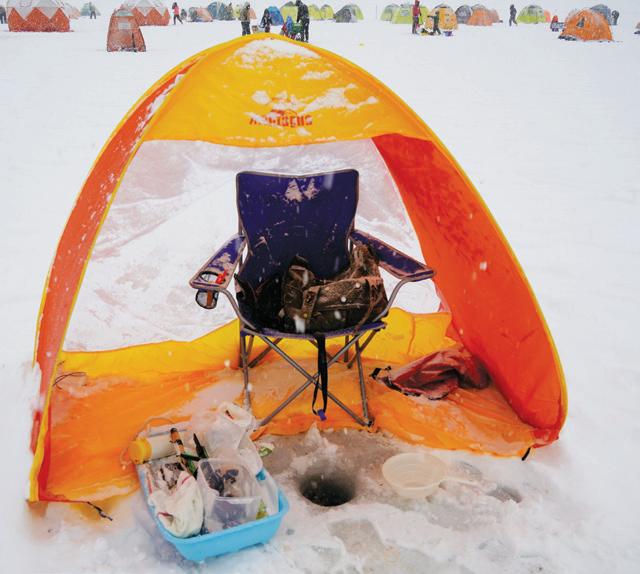
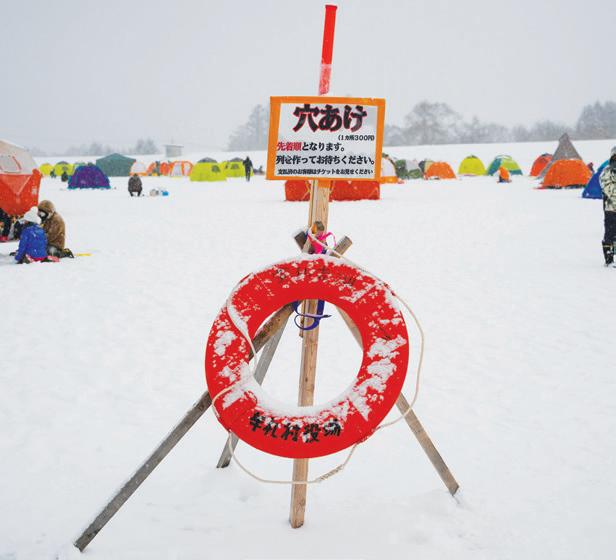
to hook any. Perhaps the weight was a bit too much, so I tried a smaller one. Still no luck.
This pattern went on for about an hour; changing baits would get bites but no hook-ups. With the temperature now 10 degrees Fahrenheit, the wind was picking up and snow was blowing into the tent, covering everything and making it hard to even change bait. The air was so cold it froze the rod’s eyelets – and the bait if I left it out of the water long enough. I also couldn’t feel my fingers to even pick up the small maggots I was using as bait.
It was time to head home after being defeated by finger-sized fish on a frozen lake in the mountains of Japan.
Later, after warming up in the shower, I looked into how long the season is open on Reisenji Lake. Year after year I would be too late and the information would say it had just closed for the season. February is the only month it is open for ice fishing.

Sawa’s tent makes for a great shelter on a sunny summer beach, but it only offered limited protection on a brutally cold, windy winter day in Japan! (LANCE SAWA) Soon it was hard for him to bait his hooks with the maggots he’d brought to tempt the lake’s smelt. (LANCE SAWA)
This sign says that would-be ice fishing warriors can have a hole drilled for what amounts to about $3 in U.S. currency.
(LANCE SAWA)


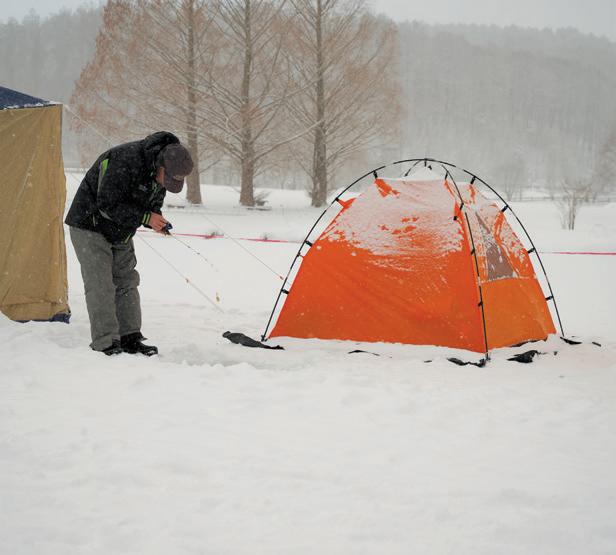
As in Alaska and the upper Midwest, ice fishermen in Japan find a way to have a good time despite the frigid conditions. (LANCE SAWA)
One month only! This lit a fire under me to quickly head back out when the weather would permit it. That day was a Thursday.
I ARRIVED THIS TIME not at 6 a.m., but
a little later, at 8 in the morning. I asked around about which fishing rig to use. The kind woman on site sold me a slightly different one than what I had used the previous outing.
Having only fished for about an hour last time, I still had plenty of bait. They drilled another hole for me near a spot someone had caught 100 fish from that morning. I set up the same tent, which again didn’t do a great job against the weather.
And once again the bites came fast, but this time I actually hooked some of them. One at a time the fish were coming up. The sun was also out and it wasn’t snowing; what a wonderful day to be out. There weren’t as many people because it was a weekday, so the whole atmosphere was more
EUGENE, OR Maxxum Marine (541) 686-3572 1700 State Hwy 99 N lloyd@maxxummarine.com www.maxxummarine.com

The second time out proved to be a more productive day for the author, who caught enough tiny but tasty Japanese wakasagi smelt to bring home for a

feast. (LANCE SAWA)
relaxed. The smelt seemed to like the salmon eggs I fished with; maybe it was something they normally don’t eat.
As the morning went on, the weather slowly got worse. First, the wind picked up, which pushed the small tent around. Then, the temperature dropped, or at least the wind-chill factor made it feel that way. Finally, the snow started to fall, but through it all the fish were still biting.
Again and again a bite would bring me back to the hole in the ice to pull up a small fish. A twitch or pull on the line in one direction would tell me a fish was interested in the bait.
In total I fished for about two hours before the weather pushed me out. My thoughts turned to how I was going to eat the few fish I had been catching. Last time I caught these small ones, I tempura-fried them, which was nice. Another option was to make a light stew broth with them as a base to help warm me up. The previous winter I saw a recipe for pickled fish, but decided that was a bit too much.
What I really like to eat is a rich soy sauce base with ginger, creating a slightly spicy fish. It’s something that I can eat with fresh steamy rice, so that was what I made.
I’d caught about 15 wakasagi smelt through the ice, and I lost more due to their paper-thin lips slipping free of the hook. As I was leaving, the owner of the operation came out to chat and asked how it went. I told him I caught about 15, but that the cold was a bit too much for me. He laughed and handed me a few more fish in a bag as a present, and he also offered an invitation to return another day.
I plan to accept as soon as the weather allows me to do so. CS


FROM FIELD...

FROM FIELD...
Turkey hunters are defying nature by trying to call a tom to them, which is why decoys, like this mating pair of Dave Smith Decoys, can make a big difference in getting toms to
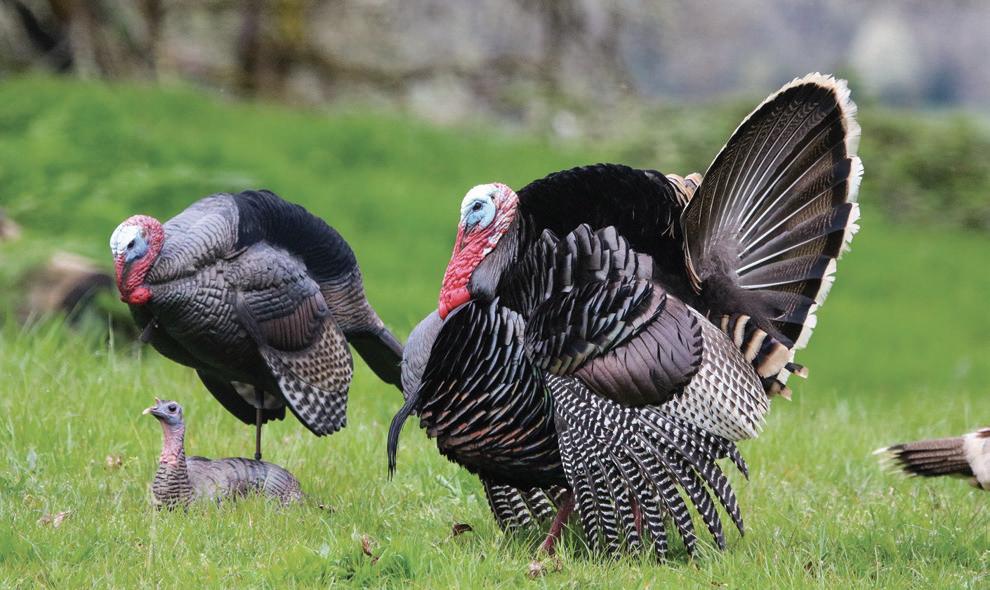
commit. (SCOTT HAUGEN)
ON THE TRAIL OF A TOM
HOW TO SET YOURSELF UP TO HUNT SPRING TURKEYS
By Scott Haugen
When it comes to spring turkey hunting, the behavior and movements of toms change throughout the season.
By the time the spring hunt opens – March 27 for the 2021 season – most of the hen turkeys have been bred, but they may not start sitting on their nest until after the hunting season begins. For this reason, toms often stick close to hens during the first few weeks of the hunting season, making it challenging for hunters to coax gobblers within shooting range.
CALLING IN A TOM
Hunters can locate turkeys by using owl, crow and even peacock calls to elicit a gobble from a tom. These locator calls can be used right before dark with turkeys on their roost in order to figure out where to start hunting the following morning, or before turkeys leave the roost early in the morning, before daylight. Once a tom gobbles, pinpoint its location and move to a position to set up and start using turkey calls to bring it in.
If tom numbers are low, they are often less likely to leave their strutting ground and the hens in the area to check out a random hen that’s calling in the distance. For this reason, it’s a good idea to sneak in close to a tom
... TO FIRE
A trip to foodie-inspired New Orleans can inspire chefs to get really creative with recipes. Tiffany Haugen was no exception and created this stir-fry wild turkey dish. (TIFFANY HAUGEN)
FEASTING, FRENCH QUARTER-STYLE

By Tiffany Haugen
While eating our way through New Orleans, many dishes motivated me to jot down flavors and textures I could try to recreate with wild game and fish.
Wild turkey can be tricky to tame, requiring proper field care and proven cooking techniques. Very often we’ll separate the breast meat, cooking it hot and fast in a stir-fry or pounded thin for cutlets.
The rest of the turkey will always benefit from slow or pressure cooking. If looking for something you can quickly do with any or all of your turkey, look no further than this flavorful Instant Pot recipe.
3 pounds wild turkey 2 tablespoons olive oil 1 cup chopped onion 1 cup chopped green bell pepper ½ cup chopped red bell pepper Four cloves garlic, chopped 2 teaspoons paprika 1 teaspoon chili powder 1 teaspoon black pepper 1 teaspoon oregano 1 teaspoon thyme 1 teaspoon red chili flakes 1 teaspoon salt 2 cups chicken broth One jalapeño pepper, thinly sliced ¾ cup sour cream
If using legs and thighs, separate at the joint. If using turkey breast meat, cut into large chunks, about the size of a fist. Place olive oil in Instant Pot or pressure cooker and sauté onion, bell peppers and garlic until onions are softened.
Add seasonings and continue to sauté for one to two minutes. Add turkey pieces and brown on all sides, then add chicken broth and seal the Instant Pot. Cook on high pressure for 25 minutes. When the meat has pressure cooked, use the quick release button and let the pressure off.
Once it’s safe to remove the lid, remove all turkey pieces. Add sliced jalapeño peppers and whisk sour cream into the turkey liquid. Let turkey cool slightly and, using a fork, pull all the meat from the remaining bones. Add “pulled” turkey back to the Instant Pot and simmer, allowing the liquid to thicken. Serve in a bun, over biscuits or rice, or stir cooked pasta into the turkey mixture.

Editor’s note: For 150plus more great bird recipes and signed copies of Tiffany Haugen's popular cookbook, Cooking Game Birds, send a check for $20 (free S&H) to Haugen Enterprises, P.O. Box 275, Walterville, OR 97489, or order online at scotthaugen.com.

prior to calling. If you can get within 100 yards of a tom that’s sticking tight to its strutting ground without being seen or heard, you have a better chance of calling it in.
Conversely, if tom ratios are high and the competition to breed is intense, set up further away and call. Having an eager tom travel a quartermile or more to check out your calls is not uncommon early in the spring season where hens are sparse.
KNOW YOUR PURPOSE
Remember, as hunters we are defying nature when we sit in one place and attempt to call a tom turkey to us. In the wild, toms establish a strutting zone and go there nearly every day to gobble, strut and wait for hens to come to them. As hunters, we’re calling and simulating a hen that won’t budge, and trying to convince a tom to leave its comfort zone to check us out.
If a tom is located the night prior to the hunt, get to your designated spot at least 30 minutes before legal shooting light the following morning. If hunting from a ground blind, setting it up the night before will allow you to silently slip into it come morning. Turkeys don’t like flying in the dark, which is why it’s important to get into position before the first hint of light.
Once a tom is located, figure out a plan of attack. This may mean moving quickly or waiting until another day when the bird is in a more approachable position, as was the case here in the hill country east of Redding. (SCOTT HAUGEN)
LOCATION, LOCATION, LOCATION
If locating a tom before sunup, quickly decide where the best place is to set up and get there, fast. By setting up in the dark the chance of a turkey busting you greatly decreases. If you do accidentally make noise when approaching your calling location, quickly get to your spot and sit in silence. Letting an area settle down for
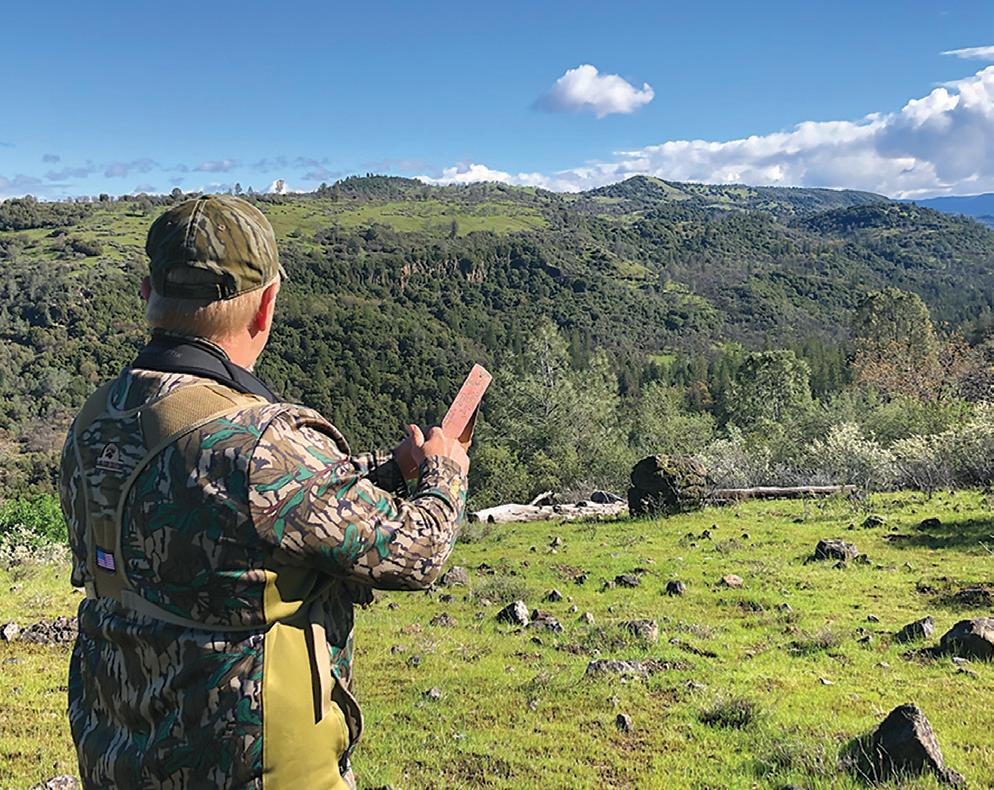

Author Scott Haugen roosted this tom the night prior to filling his tag, and was set up well before daylight with a decoy and ground blind. (SCOTT HAUGEN)
15 minutes or so once you’ve set up is wise.
When getting into a calling position, it’s best to have any wind at your back; that way the sounds of your calls carry toward the tom. Fortunately, turkeys have a poor sense of smell, so their winding you is not a concern.
If winds are heavy you may not hear a tom gobble back at you. In this situation, it’s better for a tom to hear your calls than you calling into a stiff wind, where the bird might not hear the sounds you’re making.
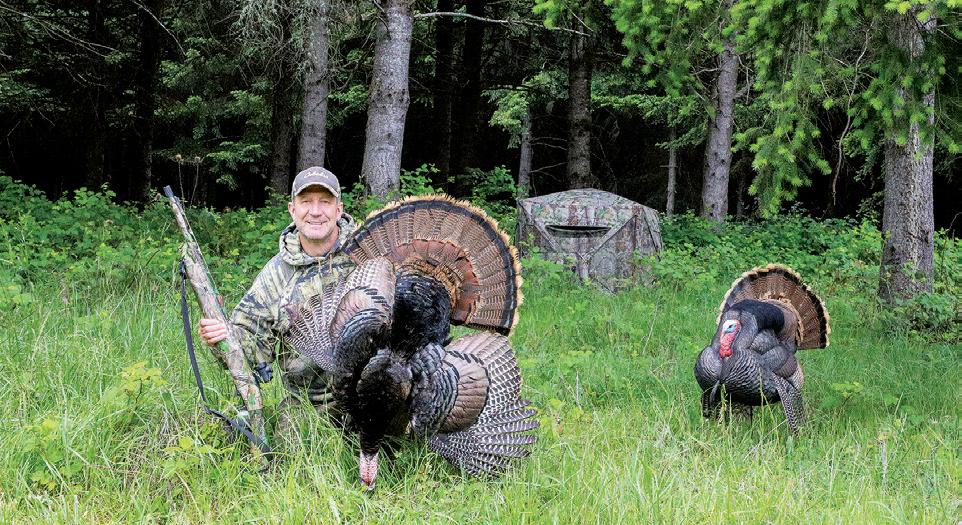
GET TO WORK
Once at your calling location, quickly and quietly get set with all the gear you’ll need. If using a slate call, arrange the strikers on the ground next to you. Lean the strikers on a stick so the tips are elevated; this way they won’t get wet or dirty on the end, which can render them useless.
If using multiple box calls, have them next to you, not buried in a pack or vest where you won’t be able to get to them without making noise. If using diaphragm calls, put one in your mouth and have others in an easy place to access. The objective is being able to reach all your calls with minimal movement and sounds, so as not to spook approaching toms.
STAYING STILL
When a turkey is in sight, don’t move. Turkeys have eyesight that’s equivalent to a good pair of binoculars, and they see in color. You should move only when a turkey is out of sight, has its head down or its head is behind a fanned tail.
If a tom doesn’t come in, come back to hunt him another day, and maybe from a different angle. There are many reasons a tom may not come in, and not all of them are the fault of the hunter. In this case, head to another hunting location and start over.
DON’T LET THEM SEE YOU
When setting up on turkeys in the daylight, it’s important to utilize cover while you’re moving. Turkeys have great vision, and if they see you there’s virtually no chance of calling them in. If hunting from a ground blind, position it where a turkey has a clear approach lane.
Turkeys like traveling along the path of least resistance, so having game trails, openings with few impediments – even fields or meadows – will increase the likelihood of a turkey approaching your calls. This is where a decoy also comes in handy; for once a tom sees it, the bird will be more motivated to cover ground.
BE STEALTHY
By moving wisely – without being seen – turkey hunters greatly increase the odds of calling in a tom. Remember, wild turkeys have a lot of natural predators in the woods and are very aware of what’s going on around them at all times.
The more stealth a hunter employs in spring, the greater their chance of filling a gobbler tag. CS
Editor’s note: For signed copies of Scott Haugen’s best-selling book, Western Turkey Hunting: Strategies For All Levels, visit scotthaugen.com. Follow Scott’s adventures on Instagram and Facebook.

